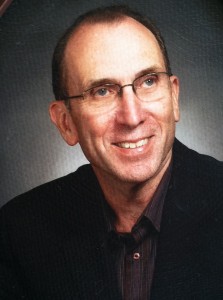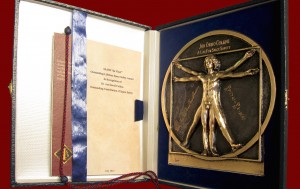
Leonardo da Vinci, the prototypical Italian Renaissance man; Jon Collins, the Renaissance man of Space Safety. The International Association for the Advancement of Space Safety (IAASS) recognized the outstanding contributions of Jon Collins by bestowing upon him the “da Vinci Lifetime Achievement Award for Space Safety”.
Early on, Jon Collins recognized that to achieve our dream of space exploration that we as a community of spacefaring nations must be able to effectively manage risks from the launch and reentry of spacecraft. This required developing technology for quantifying risks based on principles of physics and probability theory and assuring that such methods be applied by the world community of spacefaring nations.
Jon has achieved all of this. He has been a pioneer in the development of physics-based models for launch and reentry risks, he has built a team of world class modelers so that risk management methods can be grounded in physics based methodologies, and he has shared this technology in published papers, guidelines and courses with his colleagues, first in the United States and then in the international community.
Jon is a technical innovator, a leader, a teacher and a mentor to those of us who have had the privilege of working with him over the years.
Jon’s most notable technical achievements have been in the arenas of debris risk analysis, explosive risk analysis, and managing catastrophic risk. These included the introduction of the debris footprint, and the development of models for characterizing of the effects of explosions including glass breakage, and the development of risk profiles as a practical tool for managing catastrophic risk. He demonstrated that risk profiles, depicting the probability of one or more casualties, two or more casualties, and so forth, are a highly effective way of communicating catastrophic risk potential. Jon’s next important insight was that decision makers needed to understand the uncertainty in launch safety risk analyses. Jon developed an approach for quantifying the uncertainty in the assessment of casualty expectation. He further developed a procedure for including this assessment in the decision process.
 Jon has been instrumental in establishing launch and reentry safety risk analysis methodologies throughout the United States. Jon was a primary author of the U.S. Department of Transportation foundational report on “Hazard Analysis of Commercial Space Transportation.” He was a primary author of the comprehensive Flight Safety Analysis Handbook recently published by the U.S. Federal Aviation Administration (FAA). He was the author of the majority of the material that now constitutes the Flight Safety Code published by the Commonwealth of Australia Space Licensing and Safety Office (SLASO). He was a leading contributor in the development of US Air Force requirements for space safety, such as EWR 127-1 and AFSPCMAN 91-710. He was a key member of the working group that initiated the alignment of practices at the U.S. Eastern and Western Ranges. He has been an active participant in the U.S. Range Commanders Council committee that has established a common basis for risk analysis and risk acceptability determination in the United States. Most recently, he has served as an active member and Fellow of the IAASS, sharing technology through papers and the Launch and Reentry Safety courses associated with its conferences.
Jon has been instrumental in establishing launch and reentry safety risk analysis methodologies throughout the United States. Jon was a primary author of the U.S. Department of Transportation foundational report on “Hazard Analysis of Commercial Space Transportation.” He was a primary author of the comprehensive Flight Safety Analysis Handbook recently published by the U.S. Federal Aviation Administration (FAA). He was the author of the majority of the material that now constitutes the Flight Safety Code published by the Commonwealth of Australia Space Licensing and Safety Office (SLASO). He was a leading contributor in the development of US Air Force requirements for space safety, such as EWR 127-1 and AFSPCMAN 91-710. He was a key member of the working group that initiated the alignment of practices at the U.S. Eastern and Western Ranges. He has been an active participant in the U.S. Range Commanders Council committee that has established a common basis for risk analysis and risk acceptability determination in the United States. Most recently, he has served as an active member and Fellow of the IAASS, sharing technology through papers and the Launch and Reentry Safety courses associated with its conferences.
As a young man Jon had a great interest in art, architecture, and aeronautics. Being his own worst critic he did not feel he had enough talent to excel as an architect, so he ventured into aeronautical engineering. His passion for the arts survived in his becoming a serious patron of the arts and amateur sculptor.
And, of course, to all who met Jon, one can never forget his joy in getting to know you – he loves to hear about others’ activities and passions, and always asks probing, but not too probing questions.
Jon is assuredly worthy of an award honoring the modern day Renaissance man.
– Jerry Haber

















































































































![A trajectory analysis that used a computational fluid dynamics approach to determine the likely position and velocity histories of the foam (Credits: NASA Ref [1] p61).](http://www.spacesafetymagazine.com/wp-content/uploads/2014/05/fluid-dynamics-trajectory-analysis-50x50.jpg)



Hear hear! Jon Collins is most deserving of this lifetime achievement award. Jon is an awesome engineer, an inspirational leader, a wonderful human being, and my personal hero based on many years of direct personal experience with Jon in several capacities. Many thanks to IAASS for bestowing on him the honor of being the first receipient of the “da Vinci Lifetime Achievement Award for Space Safety.”
It has been my personal and professional pleasure to have worked with Jon on and off for over 20 years. He was the right guy in the right spot at the right time to bring Range Safety into the 20th Century. He has many disciples of the the physics based approaches he espoused and I am one of them. Thanks you Jon for your great contributions and your friendship.